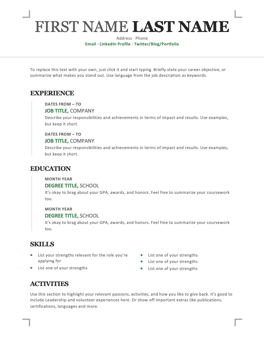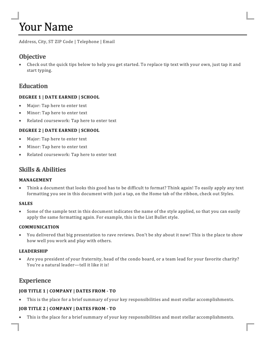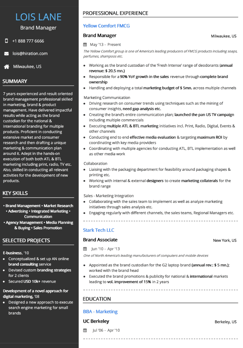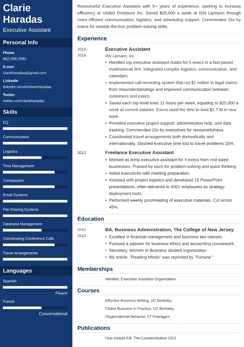How to Make Your Resume Stand Out
A resume is your first impression and a virtual handshake. Without a stellar resume, employers may overlook even the best candidates.
For an employer, it's not just about what's in the resume but also how it looks. According to Indeed, employers look at a resume for six to seven seconds before moving on to the next candidate.
Lucky for you, at Inova Staffing, we've identified the best ways to format your resume so you stand out to even the most experienced hiring teams.
What Resume Format Works Best?
There are many ways to create a resume—We recommend using online tools such as Microsoft Word or Google Docs. There are four main ways to format your resume. You'll need to find the best template depending on your prior work history and skillset. We dive into each format below so you don't miss an opportunity to show employers just how great you are!
A chronological resume starts with an introduction and then provides an overview of your professional history, starting with your most recent job at the top. This popular formatting style works for applicants with varying levels of experience.
If you are a new graduate or returning to the workforce, there is a different format for you—keep reading! Or, to get started today, you can download our comprehensive job seekers ebook.
A functional resume is formatted to showcase your skills and abilities. This type of resume is best used by those with employment gaps or
those who have changed careers. In this example, the experience is listed at the bottom and is brief and fact-based. You can use a sentence for each bullet point. Be sure that what you include is accurate and that you can demonstrate the skills if needed.
A targeted resume is written with a specific job in mind and is tailored to each application. You should consider the job listing and its keywords to highlight your relevant skills and experience, showing that you are the top candidate for that position. If the job description says you will manage the company's internal filing system, your experience or job description section could read, “Oversaw internal filing system”—if you have that knowledge, that is.
In formatting a combination resume, you will combine aspects of a functional resume and a chronological resume. You will focus on both experience and skills equally to communicate your qualifications. In our example of a combination resume, each work section contains a header for a skill with bullet points that further convey the experience.
When you begin to draft your resume, it's essential to consider which format will show who you are as an employee. Each resume format is different, just like each applicant. Make your decision based on the needs of the employer and your experiences. Your resume will certainly stand out if you keep these formatting tips in mind.
Related Resource:
Dive deeper into what type of information you should include in each section of your resume using this guide.
What You Should Include in Your Resume
What a potential employer may look for varies depending on your industry and the job you’re applying for. In general, hiring managers seek resumes that stand out. In addition to looking professional and organized, you'll want to ensure you include the essential information about yourself. Every resume should include the following:
Contact details
Include all the fundamental details in an easy-to-read header, such as:
- Full name: Use your full first and last name, no nicknames. Keep this consistent throughout your correspondence with the company.
- Current role or identify the job you are applying for here: "Seeking a full-time position as {insert position title}.”
- Location is optional: If you choose to include a location, use City, State format and abbreviate the state: Boston, MA.
- Phone number: Feel free to add easily recognizable icons instead of the word “phone.”
- Email address: Using a professional-looking email address for your resume is necessary. Do not use your current work address or the email handle you drafted in the 7th grade if it’s not workplace appropriate.
Introduction
A professional summary is an opportunity to express your interest in a role and allows the hiring manager a quick look at who you are and how you can be a valuable asset to their team.
When writing your professional summary, keep the following tips in mind:
- Describe your strong character traits.
- Mention your current job title and professional experience. If this doesn't apply to you, skip to number three.
- Include how you plan to help the employer achieve its goals.
- Add information on your key achievements or accomplishments.
- Limit the summary to three to five sentences and use a numbering system whenever possible.
Education
Include your most recent degree or education in progress, the name and location of your school, and any relevant coursework.
Experience
List your work history here. Include previous titles, employers, and any relevant experience for the role. If this is your first job, you can list volunteer work or any leadership positions you held in a team setting.
Skills
In this section, tailor hard and soft skills to the position you are applying for. Hard skills are learned through experiences like using tools, equipment, or software. Soft skills include personality traits like leadership, communication, teamwork, time management, and more.
What not to include
Don’t add salary requirements, infographics, or photographs. You can leave references off your resume unless the job description states otherwise. Most employers will ask for this information later, so have a few professional and personal references ready.
If you're looking for help crafting your resume, we've created a free resource available to job seekers. Click the button below to get started.
Going The Distance
Once you've covered all the important basics, there are a few extra steps you can take to stand out from the crowd:
Include relevant links
Including links allows your first impression to go the extra mile. You can include a portfolio, a LinkedIn profile, or a personal website.
Include personality test results
Personality test results can offer insight into how you may operate at work. Try it now.
Tailor your resume to the employer
Take a look at the company website. What colors do they use? If you can, implement them into your resume. For example, you could use the company’s brand colors in your header background or the text used throughout your resume.
Interested in More Employment Resources?
Whether you are looking for a job or seeking new candidates, the Better Together Blog is packed with advice and insights to help you succeed. Subscribe below to receive the latest content in your inbox—directly from staffing industry experts.

Enter your email address to receive updates when we publish new content.








